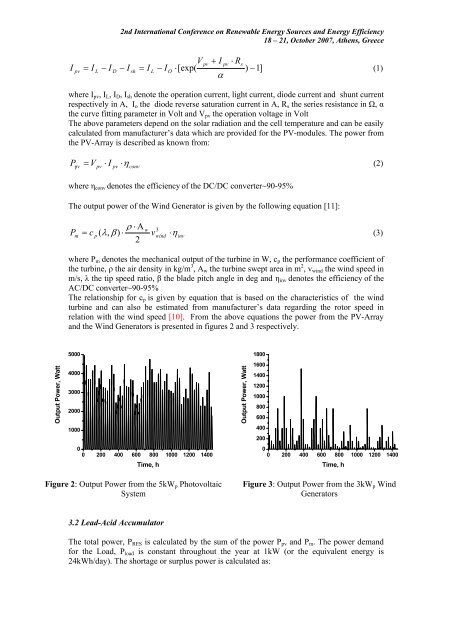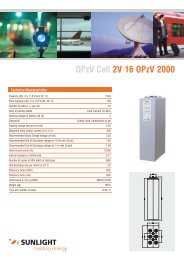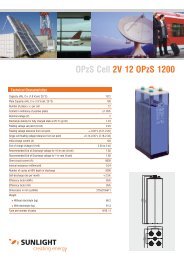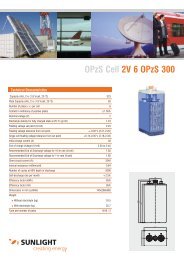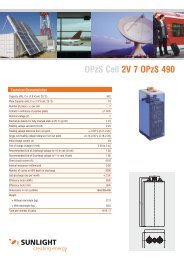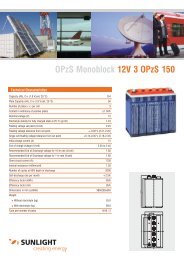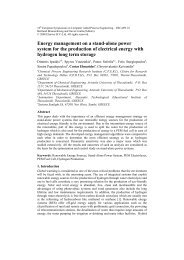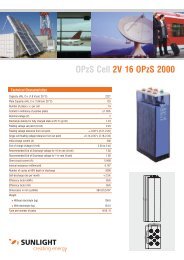analysis and modeling of a stand-alone power system for the ...
analysis and modeling of a stand-alone power system for the ...
analysis and modeling of a stand-alone power system for the ...
Create successful ePaper yourself
Turn your PDF publications into a flip-book with our unique Google optimized e-Paper software.
2nd International Conference on Renewable Energy Sources <strong>and</strong> Energy Efficiency<br />
18 – 21, October 2007, A<strong>the</strong>ns, Greece<br />
V<br />
pv<br />
+ I<br />
pv<br />
⋅ Rs<br />
I<br />
pv<br />
= I<br />
L<br />
− I<br />
D<br />
− I<br />
sh<br />
= I<br />
L<br />
− I<br />
O<br />
⋅[exp(<br />
) −1]<br />
(1)<br />
α<br />
where I pv , I L , I D , I sh denote <strong>the</strong> operation current, light current, diode current <strong>and</strong> shunt current<br />
respectively in A, I o <strong>the</strong> diode reverse saturation current in A, R s <strong>the</strong> series resistance in Ω, α<br />
<strong>the</strong> curve fitting parameter in Volt <strong>and</strong> V pv <strong>the</strong> operation voltage in Volt<br />
The above parameters depend on <strong>the</strong> solar radiation <strong>and</strong> <strong>the</strong> cell temperature <strong>and</strong> can be easily<br />
calculated from manufacturer’s data which are provided <strong>for</strong> <strong>the</strong> PV-modules. The <strong>power</strong> from<br />
<strong>the</strong> PV-Array is described as known from:<br />
P<br />
= V pv<br />
⋅ I<br />
⋅η<br />
pv pv conv<br />
(2)<br />
where η conv denotes <strong>the</strong> efficiency <strong>of</strong> <strong>the</strong> DC/DC converter~90-95%<br />
The output <strong>power</strong> <strong>of</strong> <strong>the</strong> Wind Generator is given by <strong>the</strong> following equation [11]:<br />
P<br />
m<br />
= c<br />
ρ ⋅ Α<br />
w 3<br />
p<br />
( λ,<br />
β ) ⋅ vwind<br />
⋅ηinv<br />
(3)<br />
2<br />
where P m denotes <strong>the</strong> mechanical output <strong>of</strong> <strong>the</strong> turbine in W, c p <strong>the</strong> per<strong>for</strong>mance coefficient <strong>of</strong><br />
<strong>the</strong> turbine, ρ <strong>the</strong> air density in kg/m 3 , Α w <strong>the</strong> turbine swept area in m 2 , v wind <strong>the</strong> wind speed in<br />
m/s, λ <strong>the</strong> tip speed ratio, β <strong>the</strong> blade pitch angle in deg <strong>and</strong> η inv denotes <strong>the</strong> efficiency <strong>of</strong> <strong>the</strong><br />
AC/DC converter~90-95%<br />
The relationship <strong>for</strong> c p is given by equation that is based on <strong>the</strong> characteristics <strong>of</strong> <strong>the</strong> wind<br />
turbine <strong>and</strong> can also be estimated from manufacturer’s data regarding <strong>the</strong> rotor speed in<br />
relation with <strong>the</strong> wind speed [10]. From <strong>the</strong> above equations <strong>the</strong> <strong>power</strong> from <strong>the</strong> PV-Array<br />
<strong>and</strong> <strong>the</strong> Wind Generators is presented in figures 2 <strong>and</strong> 3 respectively.<br />
5000<br />
1800<br />
Output Power, Watt<br />
4000<br />
3000<br />
2000<br />
1000<br />
Output Power, Watt<br />
1600<br />
1400<br />
1200<br />
1000<br />
800<br />
600<br />
400<br />
200<br />
0<br />
0 200 400 600 800 1000 1200 1400<br />
Time, h<br />
0<br />
0 200 400 600 800 1000 1200 1400<br />
Time, h<br />
Figure 2: Output Power from <strong>the</strong> 5kW p Photovoltaic<br />
System<br />
Figure 3: Output Power from <strong>the</strong> 3kW p Wind<br />
Generators<br />
3.2 Lead-Acid Accumulator<br />
The total <strong>power</strong>, P RES is calculated by <strong>the</strong> sum <strong>of</strong> <strong>the</strong> <strong>power</strong> P pv <strong>and</strong> P m . The <strong>power</strong> dem<strong>and</strong><br />
<strong>for</strong> <strong>the</strong> Load, P load is constant throughout <strong>the</strong> year at 1kW (or <strong>the</strong> equivalent energy is<br />
24kWh/day). The shortage or surplus <strong>power</strong> is calculated as:


